Terra Fuller: The power of carpet weaving
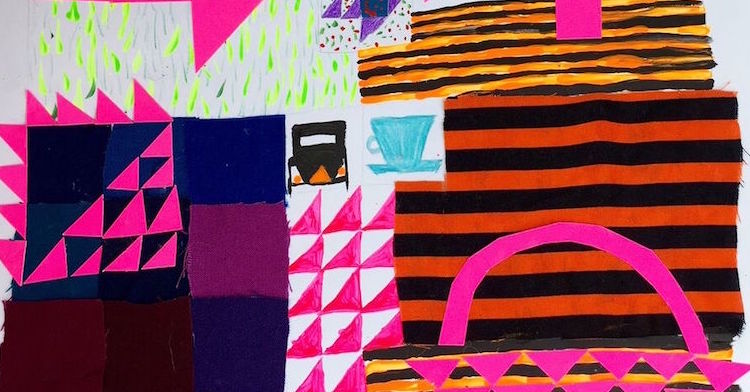
Terra Fuller received a BFA from the School of the Art Institute of Chicago, an MFA in Painting and Printmaking from Yale University and an MA in Arts Administration from Indiana University.
Her multimedia work, drawings, photographs, videos, carpets, and baskets, have been exhibited in New York City, Chicago, and Los Angeles, Berlin, New Zealand, Hungary and Wales.
After living in Morocco and working with carpet weavers for over two years, she was awarded a New Orleans Arts Council Grant to bring three carpet weavers from the Moroccan village to the USA on a carpet art tour to teach weaving workshops and exhibit their work alongside hers at galleries in the US.
Her work was most recently shown in November 2016 at Grizzly Grizzly in the heart of the alternative art spaces in Philadelphia. Terra has worked as Development Manager at the Djerassi Resident Artist Program in Woodside, California for the last two years.
In this interview, Terra explains how traveling to a variety of countries throughout her career has helped shape and develop her artistic voice. We learn which traditional methods she employs to construct and enhance her multimedia creations and why laughter, food and simple camaraderie all combine to help stimulate her imagination.
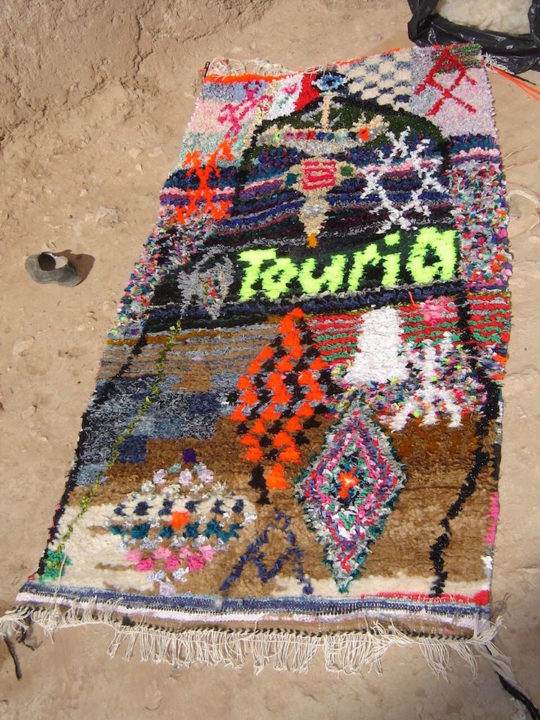
Terra Fuller, Touria Cave Carpet, hand woven carpet, 2009
Erasing distance and time
TextileArtist.org: What initially attracted you to textiles as a medium?
Terra Fuller: I had formal education in fine art, which meant painting, drawing, printmaking, bookmaking, studio sculpture. It was when I was living and working in other countries like Ecuador, Morocco, Namibia where I learned that art can function in a central role in living and is created as useful utilitarian objects, like blankets, carpets, baskets, quilts.
The first textiles I started making were carpets when I lived in Morocco, then baskets when I lived in Namibia. I worked a bit weaving blankets in Peru but didn’t get too far. Maybe someday in the future…. And now I am making quilts with a master Amish quilter from my hometown in Indiana.
Becoming in involved in textile arts was a new world for me and the genesis of textile arts fascinated me, women who become master artisans NOT through training certificates or college education or seminars, but through passing knowledge on through the female family members and neighbors, hours, years and decades of sitting together, watching each other, working together, basically living life. Most of my teachers who had a lifetime of experience and were the highest masters artisans didn’t read or write, were subsistence farmers, and even were cave dwelling nomads.
So these women became my mentors and closest friends. People may be reading this interview about me, assuming that I am some sort of expert in these textile arts. But the women I worked with would laugh so hard at that. I was by far the worst and clumsiest weaver anywhere I have been! They are true masters. They laughed at my work a lot!
And I love that women dominate the creation of textiles. Imagine that! Ironically, I have found so much adventure involved with making domestic objects. I joke that I should start a homewares line of baskets, blankets, carpets and quilts.
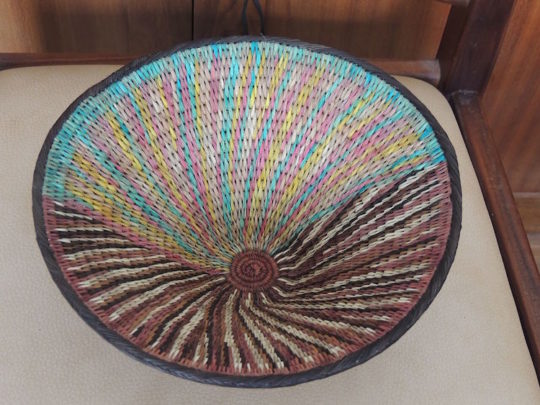
Terra Fuller, Hand woven palm basket with natural and synthetic dyes, 2014
And, more specifically, how was your imagination captured by carpet art?
It was my experience living with a family of cave dwelling nomads in the Moroccan desert that I encountered the power of carpet weaving. Zahra, the mother, was an incredible carpet artist, making beautiful and inventive art out of nothing more than reused worn out family clothing and wool from her flocks on a loom made of tree branches.
Many women there taught me to weave carpets and in harsh desert landscapes, this functional art is generally the only furniture and helps families to survive. Newlyweds sleep on the carpets, babies are conceived and are born on the carpets and the elderly pass away on the carpets. In other words, the entire cycle of life from conception to death takes place on these carpets.
Now when I sit on Zahra’s carpet in my room in California, it is as if I am having tea and visiting with my old friends, erasing distance and time. It is magical that she can be here with me, through the power of her carpet weaving.
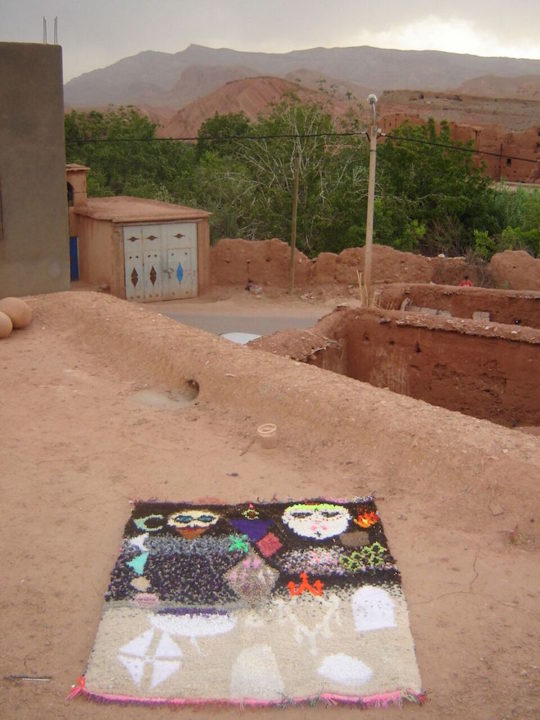
Terra Fuller, Tamazight Arranged Marriage Sleeping Mat, outdoors, 2010
Learning new techniques
What or who were your early influences and how has your upbringing influenced your work?
I grew up in rural Indiana and southern Louisiana among Amish and Cajun communities surrounded by friends and relatives who made or collected arts and crafts. My grandmother lived next to a railroad station and collected tramp art made by drifters passing by on the trains in exchange for hot meals in her kitchen. My great aunt carved wooden fishing baits in the form of worms and insects painted with glittery, shimmering eyes and tails.
As a teenager, my best friend in Thibodaux, Louisiana would give me oyster shells hand-painted with bayou scenes. The walls in our house were completely covered salon-style with my mom’s English reproduction embroidery.
Tell us a bit about your chosen techniques.
I paint, draw, make videos, take photographs, weave carpets and baskets, and am making quilts, too. The constant theme throughout my work is learning new techniques directly from people and then I adapt them to my personality, colour palette, available materials, and aesthetic. I don’t think I have ever aimed for technical perfection. Once I start to get good at it, my interest usually strays to another medium.

Terra Fuller, Collage, 2016
How do you use these techniques in conjunction with quilting and carpets?
Quilting and carpet making are totally different, except that they are flat objects in the end.
In carpets, I would buy raw goat fur and sheep wool from the cave dwelling nomads nearby, take it to the river and wash it, hand spin it, collect materials from the fields, like fig leaves, pomegranate peels, henna to naturally dye some of it, cut up old clothes and old clothes of my friends and neighbours then cut it into strips, string the loom with several other women, and only then would I start weaving. It’s similar with basket weaving, the collecting and preparation of materials can take weeks and is a workout!
With quilting, I shop around and buy premade fabrics that are pretty cheap. Then I do a lot of measuring, cutting, and sewing on my sewing machine. Quilting is a slow and laborious affair but nowhere near as slow as making knotted carpets or baskets.

Terra Fuller, Zebra Heart basket, hand woven basket with natural dyes, 2014
How would you describe your work and where do you think it fits within the sphere of contemporary art?
My work is principally shown in contemporary art galleries, mostly non-profit galleries, educational or alternative spaces. I recently put together an exhibition of baskets in my hometown library in Indiana. I am not interested in the market aspect of contemporary art but there are so many other places to become involved with.
One thing that frustrates me in the contemporary art world, people often assume I just design my pieces and then have someone else actually create them. It’s why my production quantity is not as high as many artists because weaving takes years to complete a piece so I don’t make hundreds. Only other textile artists understand and respect the labour involved.
Happy accidents
Do you use a sketchbook? If not, what preparatory work do you do?
I do some drawings of my plan for my textiles, but usually only one or two, then I jump straight in. I don’t want to plan out my pieces so much on paper that the process doesn’t create surprises for me and leave lots of room for the happy accidents.
Here are two examples of drawings I made for my carpets and then the actual piece.

Terra Fuller, Sketch for Tamazight Arranged Marriage Sleeping Mat, 2010
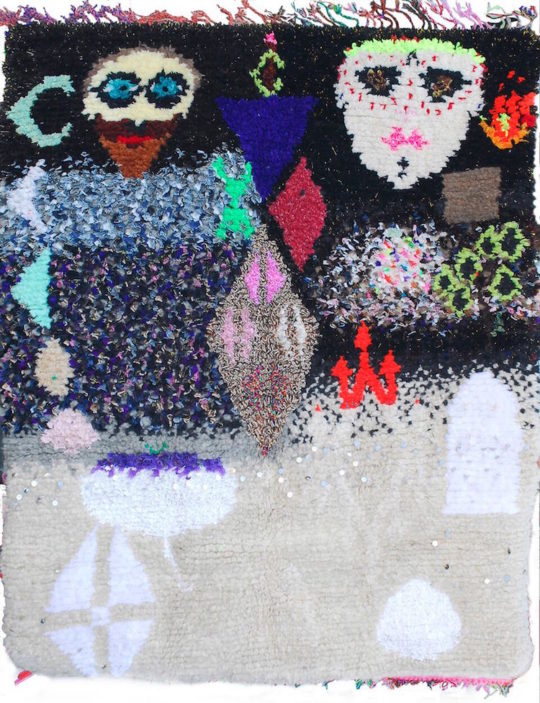
Terra Fuller, Tamazight Arranged Marriage Sleeping Mat, 2010

Terra Fuller, Working on Valley of the Roses carpet, 2010

Terra Fuller, Valley of the Pink Persian Roses carpet, 2010
Makers camaraderie
What environment do you like to work in?
I loved sitting in the sand under a big shade tree in Namibia with 5 other women and all of us working on our baskets, talking, eating, laughing, and commenting on each others designs. I always felt the camaraderie was very similar to the studio environment I have experienced with artists within the white walls of graduate school.
I definitely prefer to learn directly from other artisans or artists, not from books, the internet or videos. I also love working on my quilt while a group of other quilters work on theirs, they are usually telling funny stories, joking, and sharing lots of food!
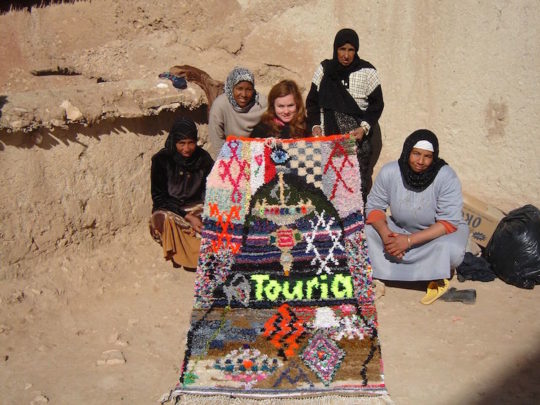
Terra Fuller with Boussain family and Touria Cave Carpet, hand woven carpet
What currently inspires you?
Currently, I am inspired by the Amish lifestyle, not just their quilts but their entire lifestyle in rural Indiana where I grew up and worldview which is divorced from consumerism and money.
But I hybridize that with the materials available to me and things I see living in a big multicultural city in California.
Who have been your major influences and why?
I was always influenced by abstract painters like Mary Heilman, Laura Owens and Richard Tuttle, then I became excited by the geometric abstraction I found in baskets and carpets and blankets.
I love folk artists like Lynn Wellford who is a painter of pets on rocks. Hex signs on barns, tramp art and prison art, and pet portrait painters all inspire me.
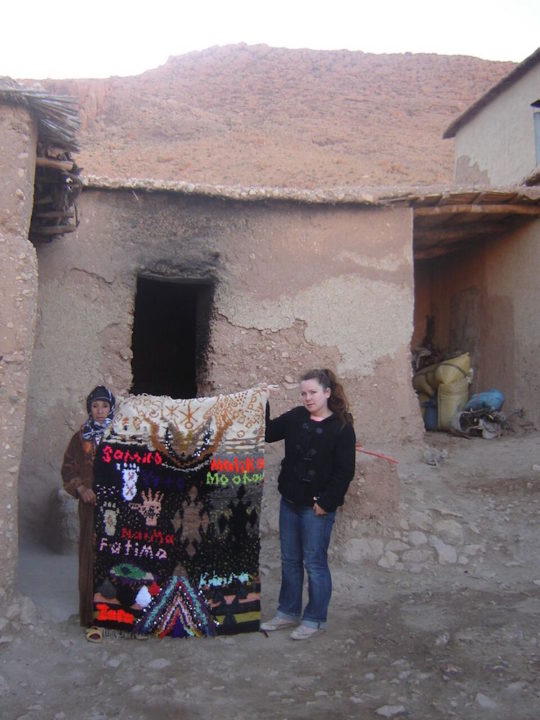
Terra Fuller and Moohou Boussain with Studio in Hdida carpet
Tell us about a piece of your work that holds particularly fond memories and why?
‘Studio in Hdida’ is a carpet I wove in Morocco in honor of my carpet mentors and has their names woven throughout the carpet (see above). The symbols include feet, hands, an eye with tears, nomad tents and caves. It is made from wool from black sheep and camel wool collected from nomad friends.
The weaving technique starts with flat weave, cedes in the middle to knotted pile, and then returns to flat weave, where I painted names and symbols onto the carpet with henna on a paintbrush. This carpet has naturally coloured wool that I dyed in a kettle over a wood fire from roots and leaves I collected from the valley.
I wove ‘Tamazight Arranged Marriage Sleeping Mat’ during the July wedding month in honor of my friend’s celebrations who married that summer. It is made of clothing such as my torn up jeans and girls wedding dresses, features the face of the bride and groom and their respective sleeping spots, fertility symbols such as eggs and sugar cones, a patch of camel fur, olives, a fire, the cycle of the moon, and Moroccan sequins.
How has your work developed since you began and how do you see it evolving in the future?
Now I am working on quilts with an Amish teacher I have from my hometown in Indiana. I am having a great time with it and can see myself making many, many quilts.

Terra Fuller, Piecing quilt, 2017
Time for reflection
What advice would you give to an aspiring textile artist?
If you don’t make money off of your work, don’t feel that it is a poor reflection on your work. The commercial art world is very different and a very different process. Reflect and examine if you want a central part of your practice to be making work commercially lucrative that sells, or if you want to make art that fulfills your creative and intellectual vision.
Yes, some artists can do both successfully. But so many artists I know, myself included, didn’t become an artist to be business woman. I became an artist for the opposite reason. But then it’s easy to become confused and disappointed when the market doesn’t snap up our creations and make us wealthy.
I think if you want to become a commercial success, focus on that and embrace it. There is no shame in it. If not, remember why you fell in love with making art in the first place and create another source of income so your art doesn’t become a source of frustration that limits you or a reminder of your commercial failure.
What piece of equipment or tool could you not live without?
Currently, it would be difficult to make my work without a sewing machine, though of course, many women hand sew.
In the past, my necessary tool would have been a paintbrush or a pencil, a loom when making carpets, or an awl when making baskets. I try to be as free of equipment as possible, no hoarding or amassing materials for me.

Terra Fuller, Sketch, 2016
Where can readers see your work this year?
I just finished an exhibition in Philadelphia at a great alternative space called GrizzlyGrizzly. Now I am throwing myself head first into making quilts and I don’t have any exhibitions planned at the moment. But you can see my work if you check back on my website and the blog that I just added to it!
For more information visit: www.terrafuller.com
Got something to say about the techniques, materials and processes used by this artist – let us know by leaving a comment below.
















I always enjoy reading about an artist’s artistic journey so much. Sometimes I think, “me too!” Or I am just struck dumb with awe.
I admire Terra’s ability to jump into different communities and learn from the women making utilitarian objects. And taking the knowledge to express herself in her own unique way.
Thank you so much for your work at textileartist.org
Well done. Really very article. I love how Terra talks about local women artisans by naming them carpet artists which is more relevant and grateful given their productions quality. Berber Carpets are still very trendy but unfortunately the artists beyond them are always undervalued.
I enjoyed knowing about Terra. Thank you